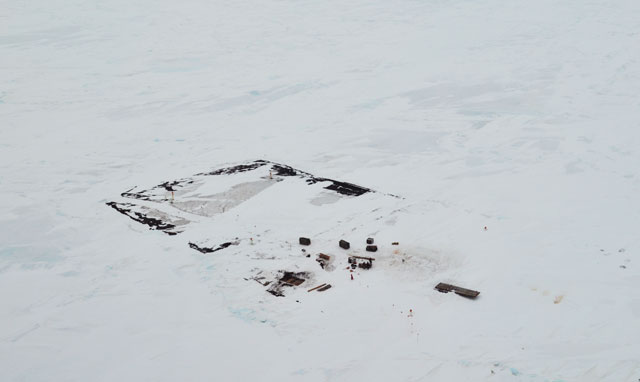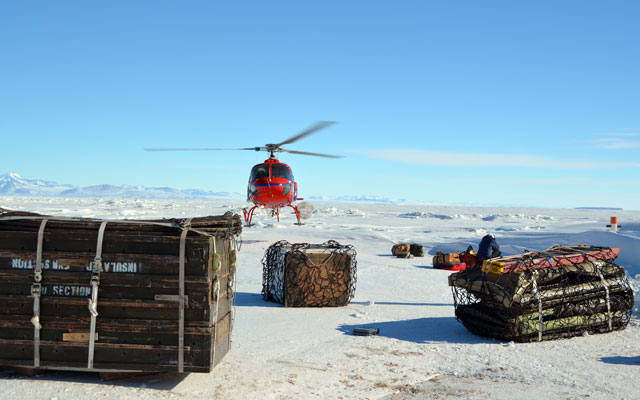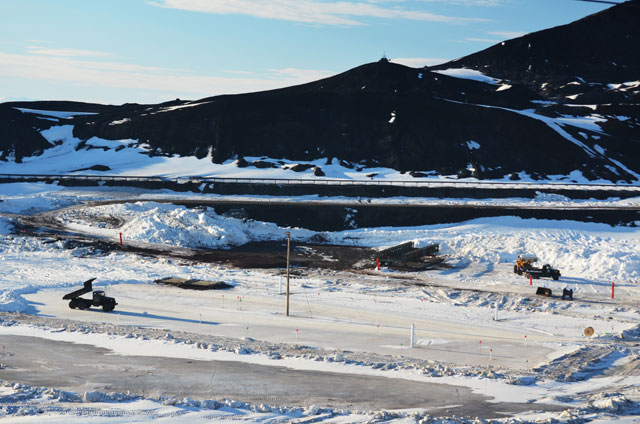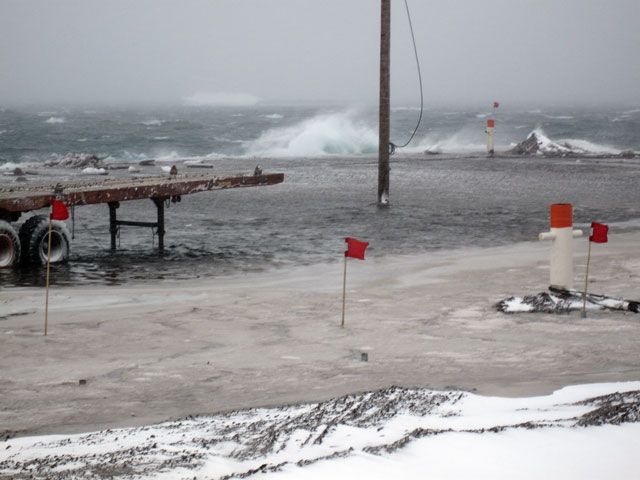|
Without pierFloating dock from McMurdo Station found locked in sea icePosted December 2, 2011
An aerial sweep of the sea ice that fills McMurdo Sound reveals a few small, snow-streaked islands and long cracks that run roughly parallel to the fast-approaching edge where the Ross Sea can be seen on the horizon. And then there are the telephone poles, vehicle trailer and Jamesway building sitting incongruously half-buried in snow nearly 30 miles from McMurdo Station How the McMurdo Station ice pier and all of the associated equipment and infrastructure ended up so far away is an easy question to answer. The more difficult problem is getting as much of the material off the ice-locked pier before it breaks loose during the summer melt and floats out to sea. “It’s got a pretty high priority,” said Kevin Pettway, lead environmental specialist at McMurdo Station for Raytheon Polar Services Co. (RPSC) The Marine Protection, Research, and Sanctuaries Act (MPRSA) The EPA permit for the ice pier allows for the release of a minimum amount of material, such as the metal cables frozen into the ice that reinforce the roughly 20-foot-thick structure, when it is finally retired. But the pier now stuck in the sea ice got away before most of the infrastructure, including bollards used to tie ships to the pier, could be removed. “It wasn’t really planned,” Pettway said. The story begins last summer when the ships that support the station began to arrive. Both the icebreaker that cuts a channel through the sea ice to the pier and a fuel ship had inadvertently bumped the floating pier, shoving it about 20 feet toward a road that leads to Hut Point, where Antarctic explorer Robert Falcon Scott and his party built a small hut more than a century ago. The first-year ice pier — roughly 1.5 times the length of a football field and about as wide — also took a hit when personnel attempted to break off a protrusion of ice below the water with directional explosives. That caused a crack to form that workers were able to “suture,” using pipes and steel cable, according to Marty Reed, RPSC Fleet Operations supervisor. “Just like a doctor would with stitching for sewing up a cut, we just run the cable back and forth with this pipe, and go out there and be like a doctor,” Reed said. But then a powerful storm swept through the region in February, blowing out the sea ice from McMurdo Sound to an extent not seen in more than a decade. White-capped waves crashed into the pier, washing onto the gravel-covered surface. The wave action eventually carried the pier away from the harbor, like an iceberg that had calved from a glacier. “They went out one morning and it had gone out to sea,” Reed said. And presumed lost. Until a helicopter pilot spotted the pier in mid-October. It had rafted out to sea for about 27 miles, almost exactly halfway across the sound to McMurdo’s helicopter fuel depot at Marble Point, before freezing into the sea ice over the winter. 
Photo Credit: Peter Rejcek
A helicopter carries a bundle of material recovered from the ice pier back to McMurdo.
Normally, Pettway’s team and other station staff could drive tracked vehicles to the site and drag everything back to McMurdo Station. But the year-old ice has behaved oddly, with several major cracks between the research station and the edge of the sea ice. A traverse just wasn’t feasible, especially with the ice edge growing closer by the day as summer temperatures climbed. “If we had been able to drive out there with some equipment and do the job properly, we could have brought everything off that pier, and probably in pretty good shape,” Reed said. Instead, the environmental team relied on helicopters to move people and tools to the site to remove as much of the pier equipment as possible, digging and shoveling out the hard-packed snow, which breaks away in Styrofoam-like chunks. Pettway did his best imitation of Paul Bunyan, using a chainsaw to bring down a pair of telephone poles embedded upright in the ice. “We’re the only lumberjacks in Antarctica,” he quipped. The telephone poles and other equipment including an entire berthing structure called a Jamesway were packaged on pallets and carried back to the station by helicopters, the loads dangling from a long cable, like a yo-yo that had bottomed out. When the ice pier again breaks free, it won’t get away so easily. The environmental team placed a tracking buoy on the ice pier to monitor its movements. Pettway said he expects the tracking buoy to last up to 18 months before the signal is lost. Meanwhile, for the second winter in a row, McMurdo Station personnel had to build a brand new pier, a process that begins after the ice in the bay has thickened enough to support equipment. Fleet operations personnel use snow to build berms along the edge of what will become the pier. The berms are frozen to create a dam that will trap water on top of the pier, as it is slowly flooded and thickened. Two separate layers of steel cable are laid across the surface to keep the sections together should cracks develop. Eventually, after the pier is about 20 feet thick, personnel top it off with a layer of rock and dirt to help insulate the ice. [See previous article At least that’s how it works during a typical winter. But an unseasonably warm season limited how quickly personnel could thicken the pier. As of November, the pier was only about half of its traditional thickness — the skinniest on record — and with only one layer of steel cable. “We just never had the super cold, frigid temperatures that you normally associate with being in Antarctica,” Reed said. “It didn’t happen — unfortunately for us.” Weather data for McMurdo show that the winter of 2011 was indeed the warmest on record since at least 2000. The average temperature between June and September was only minus 5.2 degrees Fahrenheit. The 12-year average, including this year, was minus 12.3F. During the winter of 2010, when the previous pier was built, the average temperature during those four months was minus 14.2F. A thin pier isn’t necessarily a problem for offloading fuel. It does become an issue when the cargo vessel arrives with most of the supplies for McMurdo and South Pole NSF recently decided the pier would not be usable this season. Instead, the decision has been made to tow it out of the way to Hut Point and use pontoon barges — a first for McMurdo. “It’s just one of those seasons,” Reed said.
|



For USAP Participants |
For The Public |
For Researchers and EducatorsContact UsU.S. National Science FoundationOffice of Polar Programs Geosciences Directorate 2415 Eisenhower Avenue, Suite W7100 Alexandria, VA 22314 Sign up for the NSF Office of Polar Programs newsletter and events. Feedback Form |






